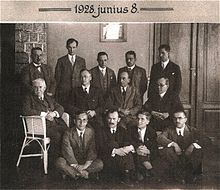Lipót Fejér
Lipót (Leopold) Fejér | |
|---|---|
 Left to right, standing: Frigyes Riesz, Béla Kerékjártó, Alfréd Haar, Gyula Kőnig, Rudolf Ortvay, on chairs:
József Kürschák, George David Birkhoff, O.D. Kellog, Lipót Fejér, sitting on the floor: Tibor Radó, István Lipka, László Kalmár, Pál Szász | |
| Born | 9 February 1880 |
| Died | 15 October 1959 (aged 79) |
| Nationality | Hungarian |
| Alma mater | University of Pázmány Péter |
| Known for | Harmonic analysis Fourier series. |
| Scientific career | |
| Fields | Mathematics |
| Institutions | University of Pázmány Péter University of Berlin |
| Doctoral advisor | Hermann Schwarz |
| Doctoral students | Paul Erdős John von Neumann Pál Turán George Pólya Tibor Radó László Kalmár Marcel Riesz Gábor Szegő Michael Fekete |
| Other notable students | Cornelius Lanczos |
Lipót Fejér (or Leopold Fejér, Hungarian pronunciation: [ˈfɛjeːr]; 9 February 1880 – 15 October 1959) was a Hungarian born Jewish mathematician. Fejér was born Leopold Weiss, and changed to the Hungarian name Fejér[1] around 1900.
Fejér studied mathematics and physics in Budapest and Berlin, where he was taught by Hermann Schwarz. From 1902 to 1905 Fejér taught at the University of Pázmány Péter and from 1905 until 1911 he taught at Franz Joseph University in Kolozsvár in Austria-Hungary (now Cluj-Napoca in Romania). In 1911 Fejér was appointed to the chair of mathematics at the University of Budapest and he held that post until his death. He was elected corresponding member (1908), member (1930) of the Hungarian Academy of Sciences.
During his period in the chair at Budapest Fejér led a highly successful Hungarian school of analysis. He was the thesis advisor of mathematicians such as John von Neumann, Paul Erdős, George Pólya and Pál Turán.
Lipót Fejér is buried in Kerepesi Cemetery in Budapest.
Fejér's research concentrated on harmonic analysis and, in particular, Fourier series.
Fejér collaborated to produce important papers, one with Carathéodory on entire functions in 1907 and another major work with Frigyes Riesz in 1922 on conformal mappings (specifically, a short proof of the Riemann mapping theorem).
Pólya on Fejér
This section contains too many or overly lengthy quotations. (November 2008) |
If you could see him in his rather Bohemian attire (which was, I suspect, carefully chosen) you would find him very eccentric. Yet he would not appear so in his natural habitat, in a certain section of Budapest middle-class society, many members of which had the same manners, if not quite the same mannerisms, as Fejér — there he would appear about half eccentric.
— George Pólya, George Pólya, "Some mathematicians I have known", Amer. Math. Monthly 76 (1969), 746–753
Pólya writes the following about Fejér, telling us much about his personality:[2]
He had artistic tastes. He deeply loved music and was a good pianist. He liked a well-turned phrase. 'As to earning a living', he said, 'a professor's salary is a necessary, but not sufficient, condition.' Once he was very angry with a colleague who happened to be a topologist, and explaining the case at length he wound up by declaring '... and what he is saying is a topological mapping of the truth'.
He had a quick eye for foibles and miseries; in seemingly dull situations he noticed points that were unexpectedly funny or unexpectedly pathetic. He carefully cultivated his talent of raconteur; when he told, with his characteristic gestures, of the little shortcomings of a certain great mathematician, he was irresistible. The hours spent in continental coffee houses with Fejér discussing mathematics and telling stories are a cherished recollection for many of us. Fejér presented his mathematical remarks with the same verve as his stories, and this may have helped him in winning the lasting interest of so many younger men in his problems.

In the same article Pólya writes about Fejér's style of mathematics:
Fejér talked about a paper he was about to write up. 'When I write a paper,' he said, 'I have to rederive for myself the rules of differentiation and sometimes even the commutative law of multiplication.' These words stuck in my memory and years later I came to think that they expressed an essential aspect of Fejér's mathematical talent; his love for the intuitively clear detail.
It was not given to him to solve very difficult problems or to build vast conceptual structures. Yet he could perceive the significance, the beauty, and the promise of a rather concrete not too large problem, foresee the possibility of a solution and work at it with intensity. And, when he had found the solution, he kept on working at it with loving care, till each detail became fully transparent.
It is due to such care spent on the elaboration of the solution that Fejér's papers are very clearly written, and easy to read and most of his proofs appear very clear and simple. Yet only the very naive may think that it is easy to write a paper that is easy to read, or that it is a simple thing to point out a significant problem that is capable of a simple solution.
See also
References
External links
- Szegő, Gabor (1960). "Leopold Fejér: In memoriam, 1880-1959". Bull. Amer. Math. Soc. 66 (5): 346–352. doi:10.1090/s0002-9904-1960-10441-7. MR 0114742.
- Birthplace of Lipót Fejér.
- O'Connor, John J.; Robertson, Edmund F., "Lipót Fejér", MacTutor History of Mathematics Archive, University of St Andrews
- Lipót Fejér at the Mathematics Genealogy Project
Further reading
Mikolás, Miklós (1970–1980). "Fejér, Lipót". Dictionary of Scientific Biography. Vol. 4. New York: Charles Scribner's Sons. pp. 561–2. ISBN 978-0-684-10114-9.
